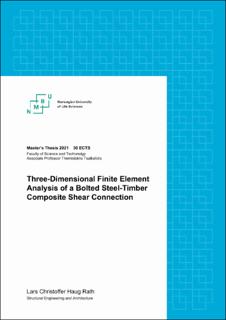| dc.contributor.advisor | Tsalkatidis, Themistoklis | |
| dc.contributor.author | Rath, Lars Christoffer Haug | |
| dc.date.accessioned | 2021-10-18T13:18:37Z | |
| dc.date.available | 2021-10-18T13:18:37Z | |
| dc.date.issued | 2021 | |
| dc.identifier.uri | https://hdl.handle.net/11250/2823718 | |
| dc.description.abstract | Timber use in construction has been growing in popularity in recent years. Increased awareness regarding sustainability is one of the main causes for this, as timber shows evidence of being less harmful to the environment than other construction materials. The construction industry contributes to nearly 40 % of the global CO2 emissions. Efforts to develop and implement sustainable solutions will therefore be necessary, to address these concerning figures. It is likely that timber will take part in some of these solutions.
A construction technique that has received increased interest recently, is steel-timber composite (STC) structures. This method aims to limit the use of concrete and steel, by replacing some of the load-bearing elements with timber. In order to join different materials together, knowledge about hybrid connections is essential.
The purpose of this thesis is to advance the research on STC connections, by conducting a finite element analysis (FEA) of a bolted STC shear connection. The connection consists of two Dahurian larch glulam elements, which are bolted to the flanges of a steel H-section, using four 6 mm bolts. A study where this connection was subjected to a pull-out test, acted as the basis for this work. The load-slip results from the experimental study were used to assess the accuracy of the FEA.
The FEM-software, Ansys Mechanical R2 2020, was used for conducting the analysis. As timber is an anisotropic material, capturing its behaviour in a numerical simulation is challenging. As a result, several modelling approaches have been developed for analysing STC connections. For this work, a method called the "foundation material model" was used.
Promising results were obtained by the analysis, and a conservative estimation of the connection capacity was provided. Similar to the experimental study, the bolts in the model were the critical parts that failed first. A two-hinge yield of the bolts developed in the model, which is the same failure mode as the experiment. The bolts failed when 47.5 kN had been applied, which is 88 % of that of the physical test. The resulting slip of the model was 5.4 mm, as opposed to the 7.5 mm seen in the experiment. Some of the other main observations from the experiment could also be captured by the model. This included initial no-slip, caused by bolt pretension, and embedment of bolt heads.
Further work involving physical tests is recommended to enable better determination of the timber material properties. Other connection configurations can also be examined, in order to investigate the potential of the foundation material model. | en_US |
| dc.description.abstract | Bruk av treverk i byggebransjen har økt i popularitet de siste årene. Større bevissthet rundt bærekraft er en av hovedgrunnene til dette, ettersom treverk viser tegn på å være mindre skadelig for miljøet enn andre konstruksjonsmaterialer. Byggeindustrien bidrar til nesten 40 % av det globale CO2 utslippet. Innsats rettet mot utvikling og implementering av bærekraftige løsninger vil derfor være nødvendig, for å adressere disse dystre tallene. Det er sannsynlig at treverk kommer til å bidra til noen av disse løsningene.
En byggemåte som har fått større interesse i det siste, er stål-tre kompositt (STK) strukturer. Denne metoden søker å begrense bruken av betong og stål, ved å erstatte deler av de lastbærende elementene med treverk. For å forbinde forskjellige materialer sammen, er kunnskap om hybridforbindelser essensielt.
Formålet med denne avhandlingen er å videreføre forskningen på STK forbindelser, ved å utføre en finite element analyse (FEA) av en boltet STK skjærforbindelse. Forbindelsen består av to mongollerk limtre elementer, som er boltet fast på flensene til en stål H-profil, ved bruk av fire 6 mm bolter. En studie hvor denne forbindelsen ble utsatt for en "pull-out" test, fungerte som et grunnlag for dette arbeidet. Last-deformasjons-resultatene fra den eksperimentelle studien ble brukt for å vurdere nøyaktigheten av FEA’en.
FEM-programvaren, Ansys Mechanical R2 2020, ble brukt i gjennomføringen av analysen. Siden treverk er et anisotropisk materiale, er det å fange dets oppførsel i en numerisk simulering krevende. Som et resultat, er det utviklet flere fremgangsmåter for å modellere STK forbindelser. For dette arbeidet, ble en metode kalt "foundation material model" brukt.
Lovende resultater ble oppnådd av analysen, og en konservativ estimering av forbindelseskapasiteten ble gitt. I likhet med den eksperimentelle studien, var boltene i modellen de kritiske delene som feilet først. To-leddet flyt i boltene utviklet seg i modellen, noe som er den samme bruddformen som i eksperimentet. Boltene feilet da 47.5 kN hadde blitt påført, noe som er 88 % av det i den fysiske testen. Den resulterende deformasjonen i modellen var 5.4 mm, i motsetning til de 7.5 mm fra eksperimentet. Noen av andre hovedobservasjonene fra eksperimentet kunne også bli fanget opp av modellen. Dette inkluderer innledende "no-slip", forårsaket av forstramming av boltene, og inntrenging av boltehodene.
Videre arbeid ved fysiske tester er anbefalt for å kunne bestemme materialverdiene til treverket bedre. Andre knutepunktskonfigurasjoner kan også bli undersøkt, for å utforske potensialet til foundation material modellen. | en_US |
| dc.language.iso | eng | en_US |
| dc.publisher | Norwegian University of Life Sciences, Ås | en_US |
| dc.rights | Attribution-NonCommercial-NoDerivatives 4.0 Internasjonal | * |
| dc.rights.uri | http://creativecommons.org/licenses/by-nc-nd/4.0/deed.no | * |
| dc.title | Three-dimensional finite element analysis of a bolted steel-timber composite shear connection | en_US |
| dc.type | Master thesis | en_US |
| dc.description.localcode | M-BA | en_US |

